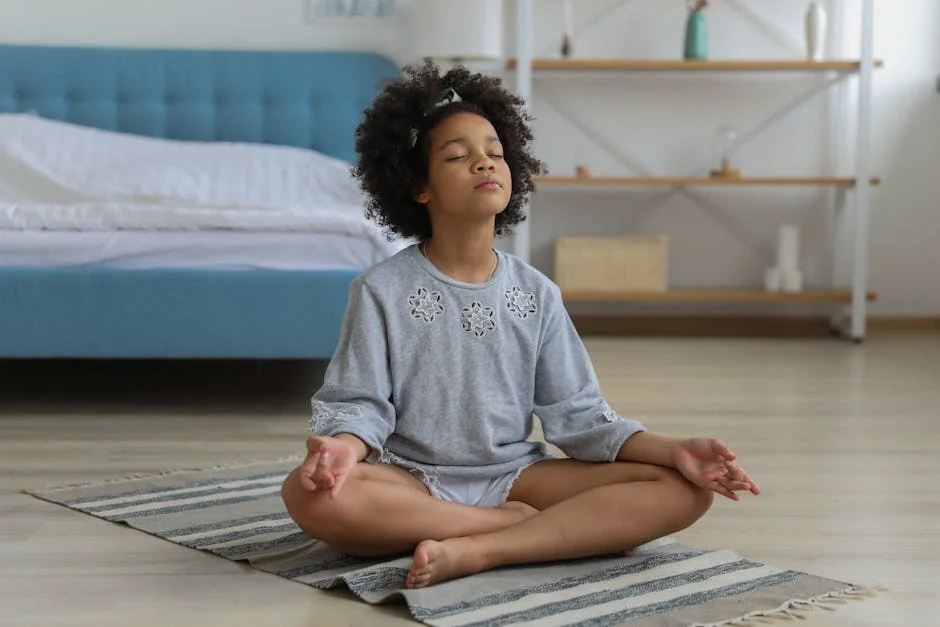Feeling overwhelmed, constantly "on," or like your brain is a browser with too many tabs open? You're not alone. In our non-stop world, finding a moment of quiet can feel impossible. But what if you had a simple, always-available tool to hit the mental reset button? This is the power of cultivating a daily practice, and this complete intro to meditation is your first step. Forget any preconceived notions of chanting for hours on a mountaintop; modern meditation is a practical, accessible skill for anyone.
This guide is designed for total beginners. We’ll demystify what meditation truly is (hint: it's not about stopping your thoughts!), explore its profound benefits from reduced stress to improved focus, and walk you through a simple, step-by-step practice for your very first session. Consider this your friendly, no-judgment starting line to a calmer, more centered you.
What is Meditation? A Simple Introduction for Beginners
Many people imagine meditation as the act of emptying the mind of all thoughts, forcing a state of blank silence. This misconception is the biggest reason beginners feel they've failed. In reality, meditation isn't about stopping thoughts at all.
Think of your mind as a clear blue sky, and your thoughts are just clouds passing by. Meditation is the practice of sitting back and watching those clouds drift past without getting caught up in the storm. It’s a training ground for awareness and focus. When you meditate, you are learning to observe your thoughts, feelings, and bodily sensations without judgment—without labeling them as "good" or "bad."
This practice has ancient roots, with traditions spanning thousands of years across cultures. But you don't need to adopt a spiritual belief system to benefit. Modern, secular meditation takes the core psychological techniques and makes them available to everyone. The ultimate goal is to create a small space between you and your reactions, allowing you to respond to life's challenges with more clarity and less stress.
The Life-Changing Benefits of a Meditation Practice
You might be wondering what you'll actually get out of sitting with yourself for a few minutes each day. The benefits of meditation are backed by a growing body of scientific research and are felt by millions of practitioners. This isn't just a vague promise of "feeling better"; these are tangible, positive changes.
- Reduces Stress and Anxiety: This is the most well-known benefit. Meditation dials down the body's "fight-or-flight" response (cortisol) and activates the "rest-and-digest" system, leading to a profound sense of calm. For a practice specifically designed for mental clarity, explore this guide on meditation to clear your mind.
- Improves Focus and Concentration: By repeatedly bringing your attention back to a single point (like your breath), you are literally strengthening your brain's neural networks for focus. This can lead to better productivity and less mental distraction.
- Enhances Self-Awareness and Emotional Health: Regular practice helps you recognize your habitual thought patterns. You begin to see, "Ah, there's that critical voice again," or "I tend to worry in this situation." This awareness is the first step toward changing unhelpful patterns.
- May Improve Sleep Quality: When you practice calming a racing mind during the day, it becomes easier to quiet it at night. Meditation can help you let go of the day's tensions and slip into a more restful sleep.
- Increases Patience and Tolerance: As you learn to sit with discomfort—an itchy nose, a distracting sound, a difficult emotion—you build patience. This newfound tolerance often translates into being more patient with the people and situations in your daily life.
How to Start Meditating: A Step-by-Step Guide for Your First Session
You don't need special equipment or hours of free time. All you need is a few minutes and a willingness to try. Here’s a simple, step-by-step guide for your very first meditation session. For a more detailed breakdown of the foundational process, you can also review these general steps to meditation.
Step 1: Find a Quiet Space and Get Comfortable
Choose a relatively quiet place where you won't be interrupted for a few minutes. Sit on a cushion on the floor, in a chair with your feet flat on the ground, or even on your bed. The key is to keep your back reasonably straight to avoid drowsiness, but not so rigid that you're uncomfortable. Rest your hands on your knees or in your lap. If you want to enhance your environment, learn how to set up a meditation space for a more dedicated practice.
Step 2: Set a Time Limit
Starting with a short time is crucial for building a sustainable habit. Set a timer for just 3 to 5 minutes. Knowing the timer will go off frees you from constantly checking the clock and allows you to fully commit to the practice.
Step 3: Notice Your Body and Breath
Gently close your eyes or lower your gaze. Bring your attention to the physical sensations of your body. Feel the weight of your body on the seat, your feet on the floor. Then, turn your focus to your breath. Don't try to force it to be deeper or slower. Simply notice the natural rhythm of your inhalation and exhalation. Feel the air moving in and out of your nostrils, or the rise and fall of your chest or belly.
Step 4: Gently Guide Your Wandering Mind Back
Your mind will wander. It's not a matter of "if," but "when." You'll suddenly find yourself thinking about your grocery list, a work email, or a conversation from yesterday. This is completely normal and is the entire point of the practice!
The moment you realize your mind has wandered, gently and kindly acknowledge it ("Ah, there's thinking"), and without judgment, guide your attention back to the sensation of your breath. This act of noticing and returning is the repetition that builds your mental muscle.
Step 5: Gently Close Your Session
When your timer chimes, don't rush to open your eyes and jump back into your day. Take a moment to notice how your body feels. Notice any sounds in the environment. Gently wiggle your fingers and toes, and when you feel ready, slowly open your eyes.
5 Easy Meditation Techniques to Try Today
Once you're comfortable with the basic practice of focusing on the breath, you can explore different meditation techniques to see what resonates with you.
Mindfulness Meditation: This is the technique described in the step-by-step guide. It involves anchoring your attention on a single point, most commonly the breath, and returning to it whenever the mind wanders. It's the foundation for many other styles.
Guided Meditation: Perfect for absolute beginners, this technique involves listening to a teacher or an app that guides you through the meditation. They might offer visualizations, body scans, or specific prompts to focus on, making it easier to stay on track.
Walking Meditation: If sitting still is too challenging, try how to do walking meditation. Find a quiet path (even a small room works) and walk slowly. Focus all your attention on the physical sensations of walking—the feeling of your feet lifting, moving through the air, and making contact with the ground.
Body Scan Meditation: This practice is excellent for relaxation and body awareness. You slowly bring your attention to different parts of your body, one by one, from the tips of your toes to the top of your head. You simply notice any sensations—warmth, tension, tingling, or nothing at all—without trying to change them. Here is a dedicated guide on how to do body scan meditation.
Loving-Kindness Meditation (Metta): This technique focuses on cultivating feelings of compassion and love for yourself and others. You silently repeat a series of phrases, such as "May I be happy. May I be healthy. May I be safe. May I live with ease," and then extend these same wishes to others.
Common Meditation Challenges and How to Overcome Them
Every meditator, from beginner to expert, faces challenges. Anticipating them can help you stay committed when they arise.
"I Can't Stop My Thoughts": This is the most common hurdle. Remember, the goal is not to stop thoughts, but to change your relationship with them. Each time you notice a thought and gently return to your breath, you have succeeded. It's a rep, like a bicep curl for your brain.
"I Get Too Restless or Uncomfortable": Physical discomfort is normal. If you feel a serious ache, adjust your position. For general restlessness, see if you can simply observe the feeling of "restlessness" in your body without immediately reacting to it. If sitting is consistently too difficult, try a walking meditation instead.
"I Don't Have Time": This is often a matter of priority. Can you find 5 minutes? Try attaching your practice to an existing habit, like meditating right after you brush your teeth in the morning or right before you eat lunch. These small, consistent sessions are far more powerful than one long, sporadic session.
"I Feel Like I'm Not Doing It Right": If you're sitting down and making an effort, you are doing it right. There is no perfect meditation. Some days your mind will be calm; other days it will be a whirlwind. The value is in the commitment to show up, regardless of the internal weather.
Building a Lasting Habit: Tips for Consistent Practice
Turning a single meditation session into a lasting habit is the key to unlocking its long-term benefits. Consistency trumps duration every time.
Start Small and Be Consistent: A daily 5-minute practice is infinitely more valuable than a 30-minute session once a month. Build the habit first, then you can gradually extend the time if you wish.
Attach It to an Existing Habit: Link your meditation to something you already do without fail, like drinking your morning coffee, brushing your teeth, or during your lunch break. This "habit stacking" makes it much easier to remember.
Create a Dedicated Space: If possible, set up a small corner with a cushion or chair. This physical anchor signals to your brain that it's time to practice. Over time, just sitting in that spot will help you settle more quickly.
Use a Meditation App for Guidance and Tracking: Apps like Calm, Headspace, or Insight Timer offer structured courses for beginners, thousands of guided meditations, and timers with soothing interval bells. They can provide the guidance and motivation needed in the early stages.
Be Kind to Yourself on Days You Miss: You will miss days. It's inevitable. When this happens, practice self-compassion. Berating yourself will only create resistance. Simply acknowledge it, and gently guide yourself back to your practice the next day, just as you would guide your focus back to your breath.
Embarking on the journey of meditation is a profound step toward greater mental clarity and emotional resilience. This guide has illuminated the foundational steps: establishing a consistent practice, focusing on the anchor of your breath, and approaching each session with patience and without judgment. The core message is refreshingly simple—meditation is not about emptying the mind, but about learning to observe your thoughts with calm detachment. The true transformation occurs not in isolated moments on the cushion, but as this cultivated awareness begins to infuse your daily life, helping you respond to stress with greater composure. Begin with just a few minutes each day, be gentle with yourself when your mind wanders, and trust in the cumulative power of this practice. The path to a more centered and peaceful you is always available, starting with your very next breath.



